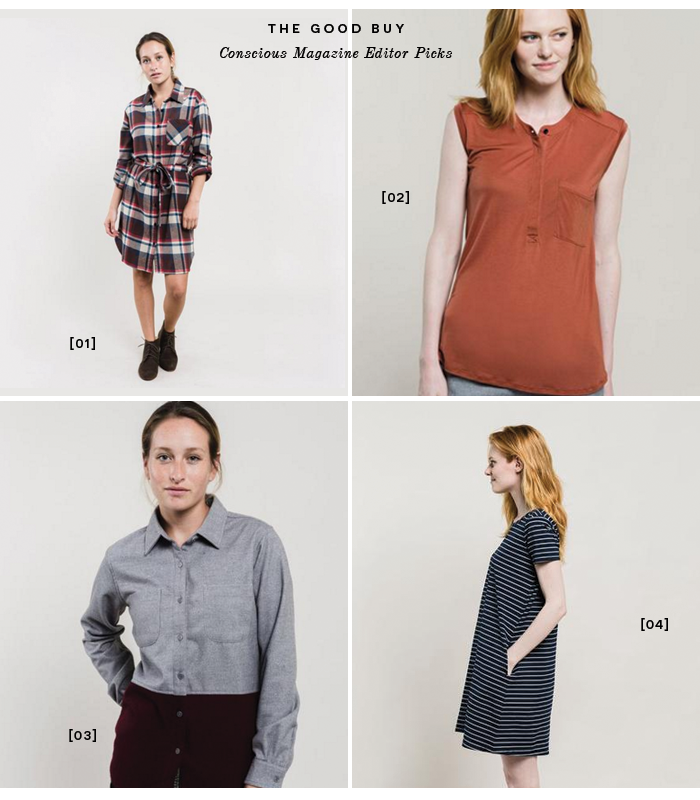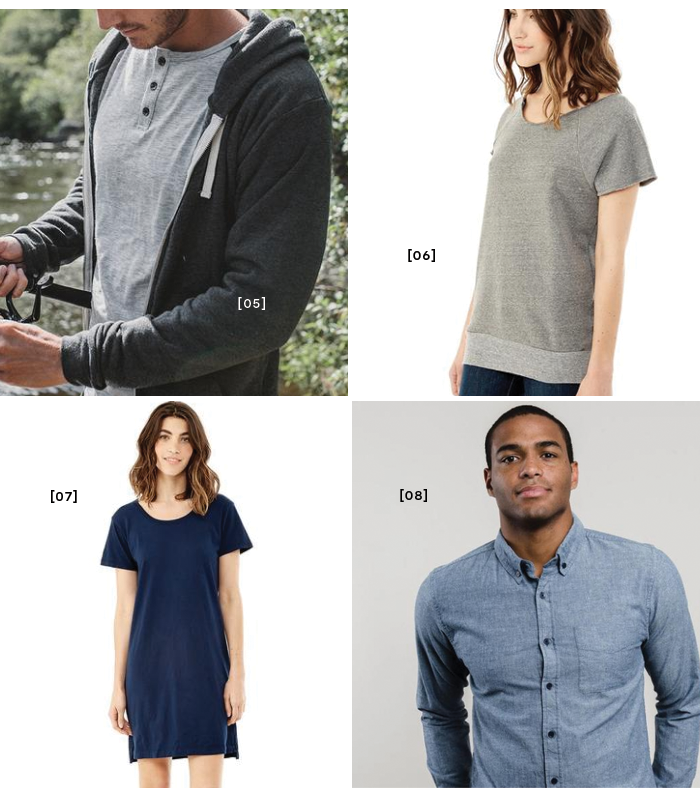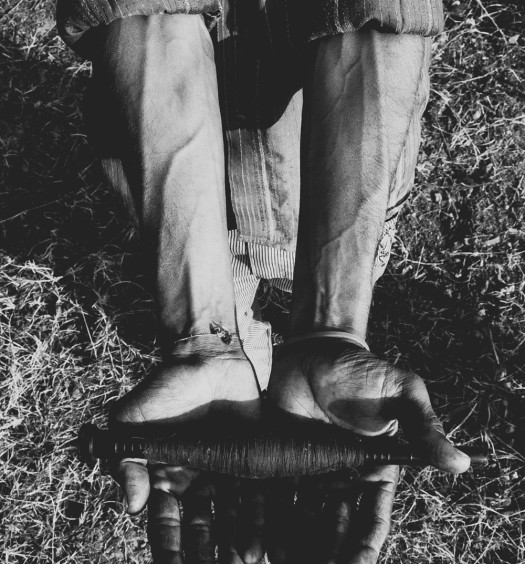10 Green Fashion Forward Pieces for Your Wardrobe (And Holiday Gift Giving!)

Photo: United By Blue, Tafton Zip Hoodie
“Materials matter.” An important phrase that we should start incorporating into our 21st-century vernacular. Though perhaps already common in some circles, we would like to explore its undeniable importance, as well as how to start adopting a few practices, in order to root it more deeply within our daily habits.
How we use precious resources tells a lot about who we are. Being thoughtful when selecting materials is one piece of the sustainability puzzle and choosing certain materials over others will help build the ecological sustainability of today’s generation, as well as the generations yet to come. Ken Geisler writes in his book, Materials Matter, “The products we purchase and use are assembled from a wide range of naturally occurring and manufactured materials. But too often we create hazards for the ecosystem and human health as we mine, process, distribute, use, and dispose of these materials.” The cycle of production and disposal of things—from the beginning to end—obviously can cause great harm to our shared environment. Concerning ourselves with materials comes in a 360 form. Whether it is with fashion, buildings, products, or how we are producing food, the materials have impact, and it has largely fallen to today’s generation to take up the mantle of sustainability to make sure that impact has a positive effect. The “going green” movement hopes to show better paths, while still acknowledging modern needs and obligations.
According to All-Reycling-Facts.com, “going green means contributing towards maintaining the natural ecological balance in the environment, and preserving the planet and its natural systems and resources.”

When buying clothes, first choose a garment that is built to last. With fast fashion sending over 650,000 tons of clothing to landfills each year, concentrate on well-constructed products in classic styles that will stick around many seasons over.
Below are 10 fashion-savvy pieces provided by The Good Buy that is worth your time and investment for pursuing a green lifestyle.
The Good Buy practices a materials matter-philosophy, therefore, all apparel curated within their online marketplace are consciously constructed from environmentally-friendly materials, sweatshop-free and fairly traded, oftentimes handmade. Plus, they believe that you shouldn’t have to trade sustainability for style—it can coexist in the same garment.

01 | Murray Plaid Shirt Dress
A versatile throw-on-and-go dress that makes layering easy as the temperatures drop throughout the season.
What materials make it good? 100% Organic Cotton. According to apparel maker, United By Blue, “Conventional cotton consumes 10% of the world’s pesticides and 25% of the world’s insecticides, despite the fact that cotton only uses 2.4% of the total arable land. Organic cotton does not use chemical fertilizers, pesticides, or insecticides which prevent it from draining into our oceans and waterways.” It’s also one of the softest materials around for making clothing and a sustainable powerhouse.
02 | The Avalon Tank
A loose draping fit with the flowing qualities of silk and the softness of cotton.
What materials make it good? Tencel. A biodegradable fiber made from eucalyptus trees, it’s an extremely fast-growing resource that requires low water and virtually no pesticide inputs to grow. Tencel uses 100% renewable energy to minimize emissions and a “closed loop” manufacturing process with nontoxic solvents. Over 99% of the solvent is recycled and pushed back into the system instead of being flushed out as waste water.
03 | Wool Colorblock Shirt
Blended with 65% recycled polyester so you get all the warmth without the usual itch of an all-wool.
What materials make it good? Wool is a natural and renewable resource (since sheep are shorn annually). Wool is also biodegradable, so it’s much gentler to the environment than oil-based synthetics.
04 | Blue Hyde Stripe Swing Dress
Made of 95% recycled content, which is one of the highest around we’ve found. And did we mention it has pockets?
What materials make it good? Recycled polyester. It’s no wonder that people who’ve gone green run from labels with the word polyester on it. Virgin poly is a man-made synthetic fabric that is resource intensive to make, involving tons of water, chemicals, and fossil fuels in the process to make a garment and leaves a lot of waste and by-product. Recycled polyester mostly shares the name: it uses PET, the same material in plastic water bottles by diverting them from landfill, recycling them, and at least giving that plastic a second shot at a useful life! It actually uses 35 – 50% less energy to produce as well.

05 | Gray Tafton Zip-Up Hoodie
Crafted from a sustainable blend of recycled polyester and organic cotton, with a soft brushed interior and regular fit,
What materials make it good? This hoodie is constructed from environmentally-friendly materials: 50% Recycled Polyester (made from recycled plastic water bottles!) and 50% organic cotton (does not use chemical fertilizers and pesticides which prevent them from draining into our oceans and waterways!). By purchasing this product you help remove one pound of trash from oceans and waterways.
06 | Gray Rehearsal Eco-Fleece Pullover
Knit on vintage machines using a blend of organic and recycled materials.
What materials make it good? Eco-Fleece (and Eco-Jersey). By combining organic and cotton materials together, blended fabrics can achieve the softness, look, and ease of care that most people seek from garments made from virgin materials. And importantly, eco-fabrics commit to using less water during the production process.
07 | Legacy Garment-Dyed Tee-Shirt Dress
Hi-lo hemline is rich navy blue.
What materials make it good? Non-toxic dyes. These dyes do not contain any heavy metals or toxic substances, nor are they petrol-chemically based. Alternative Apparel notes: “The absorption (or fixation) rate for these dyes averages 75%, which means we are able to use less dye to produce our colors and less water to rinse them in the process.” Not only good for keeping chemicals away from your skin, it saves the workers who are in contact with the dyes in much greater quantities.
08 | Bryce Chambray Shirts
An everyday classic button down shirt.
What materials make it good? Besides the organic cotton chambray we’ve already talked about, sustainability is all about the details like the Corozo buttons. Also known as tagua nut, this sustainable nut is sometimes called vegetable ivory, for its ability to be carved easily and still maintain its strength.

09 | Blue Waves Silk Shibori Scarf
Using a traditional Japanese dyeing process, beautiful ombre patterns are created.
What materials make it good? Silk. As a natural fiber, it’s a better choice than synthetics that are petroleum-based fabrics. It’s renewable and biodegradable after its useful life, and durable. Not for vegans though, as an animal has been directly involved in the production. Look for products with wild silk that allows the moth to emerge unharmed.
10 | Waxed Ash Rolltop Backpack
Though not technically apparel, we’re still talking about fabric choice.
What materials make it good? Recycled canvas. Recycling previously used threads (especially cotton!) to make new fabric is definitely a good way to extend the lifespan of materials.
LEARN + CONNECT
Visit The Good Buy
Connect via Facebook, Twitter, and Instagram
FROM THE EDITOR
At Conscious, we are inspired by stories that cause us to think differently and think big-picture and so we set out to tell stories with the help of leaders and influencers within the social good community. You can read more stories like this when you join as a member.


